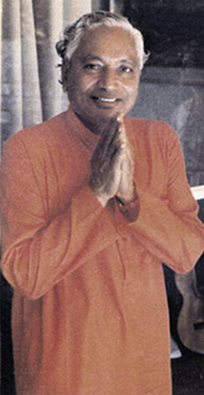About Swami Venkatesananda
Swami Venkatesananda left quite a legacy in the wake of his lifetime, but he might be the first to say that the legacy all belongs to his master, Swami Sivananda. We have photos, audios and videos of both yogis, but these pale in comparison to what it was like to experience the two in real life. In truth, you had to live with them closeup to appreciate that yoga could truly be embodied in the human form; something that many of us were skeptical of until we actually experienced the presence of these two great yogis.
Many accounts of Swami Venkatesananda, Swami Sivananda's senior disciple, are oversimplifed and misstated. Here, we attempt to present the major periods of his life in a more thoughtful and accurate manner.
Early Years
Born to a South Indian Brahmin family in 1921 and given the name Srinivasa Parthasarathy, he used to love to take part in religious observances.
 He was intelligent and full of fun. This was a trait that endeared him to many, both in his childhood and in his later life, when, as Swami Venkatesananda, he lived in Sivananda Ashram Rishikesh, and later traveled to the West, illustrating everyday concepts we live by with his humorous stories.
He was intelligent and full of fun. This was a trait that endeared him to many, both in his childhood and in his later life, when, as Swami Venkatesananda, he lived in Sivananda Ashram Rishikesh, and later traveled to the West, illustrating everyday concepts we live by with his humorous stories.
At the age of fourteen he discovered a book by Swami Sivananda in a bookshop. He was so impressed that he wrote to Swami Sivananda asking if he could join him. Swami Sivananda told him to finish his education and then come.
On leaving school he studied shorthand and typing, coming first in the examination.
After working at the Madras Corporation he obtained the position of Private Secretary to the Minister for War in Calcutta. In this capacity he was one day asked to escort some V.I.P.’s to Rishikesh. When he realized that he might be able to meet Swami Sivananda, his joy knew no bounds.
While the V.I.P.’s were resting in Rishikesh town, he went to the Sivananda Ashram office and asked to see Swami Sivananda. He was told that that Swami Sivananda was resting, and he wouldn’t be able to meet him. He was walking near Sivananda’s room when he himself unexpectedly came out of the room. He greeted Parthasarathy with “Ah! So you have come!” and Gurudev asked him to stay at the Sivananda Ashram. After fulfilling his work commitments for a year, he returned to Rishikesh to stay.
Rishikesh
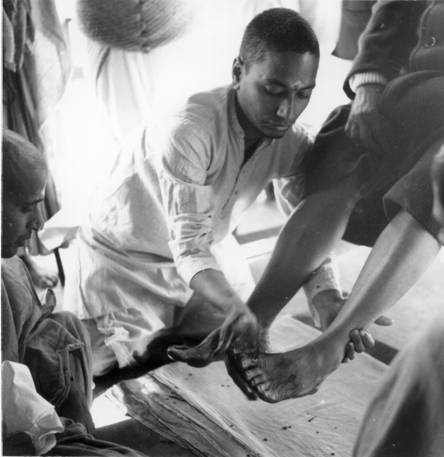 Swami Sivananda put him to work in various departments of the ashram - kitchen, temple, office, typing, the press etc.
Swami Sivananda put him to work in various departments of the ashram - kitchen, temple, office, typing, the press etc.
He then became the private secretary to Swami Sivananda, dealing with correspondence, typing books, etc. and generally helping in his day-to-day activities.
Swami Venkatesananda had a phenomenal memory. When Swami Sivananda went with an entourage in a special train (which covered India from north to south and east to west), Swami Venkatesananda listened to Sivananda's discourses during the day, and typed them out verbatim while sitting in the train toilet each night. These talks were published as "Swami Sivananda's All India Tour" (currently being reprinted in Sivananda Ashram, Rishikesh).
Swami Venkatesananda spent seventeen years at the feet of his Master, Swami Sivananda, before commencing, at his Master's request, his mission to countries outside of India in 1961.
South Africa: Early Years
9 June 1961
A Refreshing Breeze
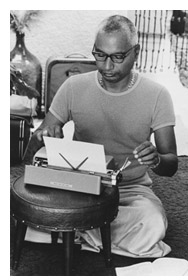 At a time when the newly born republic of South Africa stands aloof and almost completely isolated by all nations of the world because of her radical policies and when hatred and strife between the different sections of the population of this country is reaching alarming and serious proportions, the message to the new Republic of South Africa from Sri Swami Sivananda, the spiritual leader of millions of people, comes as an illuminating light to dispel the morbid atmosphere which permeates the length and breadth of our country. This all-important message of peace, goodwill and universal brotherhood brought to this country by Swami Venkatesananda, the foremost disciple of Swami Sivananda, should move all South Africans to spare some time for self-examination of the ideals and values they hold. Such an examination would reveal that materialism has driven man to seek wealth, power and fleeting pleasures, which are the basic causes of not only the problems of this country, but of all nations.
At a time when the newly born republic of South Africa stands aloof and almost completely isolated by all nations of the world because of her radical policies and when hatred and strife between the different sections of the population of this country is reaching alarming and serious proportions, the message to the new Republic of South Africa from Sri Swami Sivananda, the spiritual leader of millions of people, comes as an illuminating light to dispel the morbid atmosphere which permeates the length and breadth of our country. This all-important message of peace, goodwill and universal brotherhood brought to this country by Swami Venkatesananda, the foremost disciple of Swami Sivananda, should move all South Africans to spare some time for self-examination of the ideals and values they hold. Such an examination would reveal that materialism has driven man to seek wealth, power and fleeting pleasures, which are the basic causes of not only the problems of this country, but of all nations.
Swami Venkatesananda delivered his message of tolerance, patience and understanding in various parts of the country. It is to be hoped that this message made for men of al religions and creeds will sow the seeds for the easing of “inner and outer tensions and that eventually the right knowledge will lead man to his own salvation.” A newspaper reported: The Divine Life Society of South Africa must be congratulated for having brought into this country so eminent a personality as Swami Venkatesananda. It is hoped that the spiritual truths which he would broadcast to make man realise the vital role which religion has to play in his life will be received by men of all races, religions and language.” The typewriter always travelled with Swami. He would answer letters as they reached him – sometimes as many as 50 per week - and keep a couple of hours per day for writing his books: Bhagavad Gita Commentary, translations of Bhagavatam, Ramayana, Yoga Vasistha and the sayings of Buddha from the Sanskrit and Pali texts. Most of his talks given around the world were transcribed by devotees and printed as booklets. One unique feature of Swami’s books was that he wrote them as Daily Readings.
He would suggest that we read a page a day from each book (or the book of our choice) so that we would be exposed to uplifting and sublime thoughts each day. And at the end of one year the book would be completed. The Supreme Yoga(Yoga Vasistha) should only be read one page at a time, so one can begin to assimilate the teachings.
In Johannesburg, Jyotsna Mata made her home available to Swami and a few of his close disciples. We shared an upstairs landing where the bedroooms were located. Each morning rising before dawn we would shower then go down to the meditation room and wait for Swami to join us, which he invariably did. Those early morning meditations in his presence during the last days were very special indeed. We would often lunch together with him too and share vigorous walks around the neighbourhood. Then there would be the afternoon satsangs where we would all sit on the floor around Swami and he would entertain and instruct us in question and answer sessions or shore discourses. Tea and biscuits were brought in after an hour or so and days would pass in bliss. In the evenings there was often a talk and many people would cram the hall to hear him.
In Cape Town on previous years, Swami would stay with Sushila and Ramani in their house near to the centre of Cape Town. From here his program would be co-ordinated and satsangs and outings arranged. There was always a steady stream of devotees and disciples to the house where he was staying and each would have a task or duty allotted. Ananda Kutir Yoga Centre in Rosebank was run by Yogeshwari who played host to many of his evening speeches. From modest beginnings in a small hall in the back garden of a suburban house, Ananda Kutir Cape Town grew steadily and soon an ashram took shape. Later he traveled to Mauritius, where an ashram was established.
12 June, 1961
 Fifteen minutes before Swami Venkatesananda was to have addressed the meeting at the Avalon Theatre, the theatre was packed to capacity with people filling every available space. The foyer, the passages between the seats, alongside the walls and the gallery, together with the 1215 seats that were available must have taken a crowd or 2,500 to 3,000 men women and children.
Fifteen minutes before Swami Venkatesananda was to have addressed the meeting at the Avalon Theatre, the theatre was packed to capacity with people filling every available space. The foyer, the passages between the seats, alongside the walls and the gallery, together with the 1215 seats that were available must have taken a crowd or 2,500 to 3,000 men women and children.
The 39-year old Swami spoke for 70 minutes without showing any sign of tiredness. He told the audience that South Africa was spiritually hungry and in the quest for spiritual happiness the people looked elsewhere to find it, rather than by “gazing within themselves”. Renouncing worldly goods and pleasures in order to find “true happiness” did not mean that man must throw away his wealth and possessions. “What we must cultivate is a spirit of detachment from worldly things as they belong to the world and not to man”, he said. speaking on the steps that led to God-realisation, the Swami said that the first need was to eradicate the egotistical nature within us. The ‘I-ness’ must be wiped out from our everyday life, and in its place must be taken a complete surrender of the self. Before we can become liberated yogis, we must first learn to be non-egotistic.
We must renounce all our desires and attachment to sensual pleasures. People fear the very thought of renunciation because we haven’t learnt the real meaning of this term. It really means to renounce something that belongs to you. If one reflects a little, he will realise that nothing belongs to him, not even this body, for it is part of the earth to which it must eventually return. We must, therefore, renounce this sense of possession, this egotism. There is no need for us to run way from this world. Love and charity are also important steps in God realisation. Swami Sivananda’s greatest mantra: ‘Give’. Practical work of a selfless nature is necessary to pulverise the ego, the bar to the kingdom of God. Spontaneous, overwhelming generosity which is the trait of swami Sivananda must be implanted in all. Vanity must be eradicated by surrender and humility.
4 August 1961
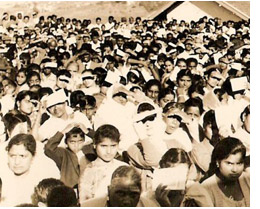 At a colourful reception organised by the Kimberly branch of the Divine Life Society of S.A at the City Hall, Swami Venkatesananda was officially welcomed on behalf of the community by the Mayor, Mr L. Jawno. Speaking on the subject “Religion for the Modern Man”, the Swami said that like diamonds, God was also hidden deep within us and it was necessary to crush tonnes of evil mass in order to discover the divine. It was time we subjected ourselves to introspection and examined ourselves to see if we were living aright. Life had a deeper purpose than mere eating and living.
At a colourful reception organised by the Kimberly branch of the Divine Life Society of S.A at the City Hall, Swami Venkatesananda was officially welcomed on behalf of the community by the Mayor, Mr L. Jawno. Speaking on the subject “Religion for the Modern Man”, the Swami said that like diamonds, God was also hidden deep within us and it was necessary to crush tonnes of evil mass in order to discover the divine. It was time we subjected ourselves to introspection and examined ourselves to see if we were living aright. Life had a deeper purpose than mere eating and living.
In order to render the soul pure, it is necessary to keep it free from unwholesome and profane influences. Much time is spent in the care of the body, very little of the soul. Every minute of our existence is precious, but we are wasting time in vain unnecessary attention on transient things. It is necessary to devote more time to the culture of the spirit. All religions were so many different ways to dig the diamond that made one spiritually rich. Yoga means the recovery of the soul and this is to be achieved through very simple practices such as service and love for one\s fellow beings, and meditating upon the Lord’s name. We must eradicate all selfish desire if we wish to be in the grace of God.
God dwells in all beings and if we could find the hidden God within us then we would have found peace. If love is enshrined in the hearts of all, then there would be no destitute, hungry or diseased in out midst. Mayoral Tea Party At a Mayoral Tea Party given in honour of Swami Venkatesananda and attended by the Deputy Mayor and members of the City Council, the Swami said that is was a tragedy of modern civilisation that it was necessary for man to resort to drugs in order to induce sleep. Sleep was God’s gift and because man had shifted himself from the centre to the periphery, of his existence, allowing the mind to be occupied with matters of a material, temporary and passing nature, he was not able to enjoy this heavenly gift.
“Standing precariously at the periphery, man is whirled in this merry-go-round called the world and he loses his head, gets worried and feels insecure. The mind is in a whirl all the time; there is no peace and there is no rest. He can have this rest only if he can restrain the mind,” said the Swami, and appealed to those who heard him to utilise the Yoga breathing at least to tranquillise their minds and enjoy freedom from tension which was ruining the health and peace of the modern man all over the world.
The technique consisted of steady, slow, graceful, rhythmic and deep breathing in and out. The ancient Yogi had discovered that mind and breath had an intimate connection; hence when the mind was tranquil the breathing was slow and steady, and when the mind was disturbed by violent emotions, the breath was heavy and laboured too. He applied this law conversely and worked his way to the mind. By steadying the breath and controlling the breathing, he obtained control over the mind. This practice had to become second nature. Otherwise, the mind had its own uncanny ways of evading control. Everyone felt that he was the master of his mind till a temptation came along and proved it otherwise.
To illustrate this the Swami gave an amusing story of a how a King who wanted to show his Ministers that his pet cat was more obedient than they, was outwitted by a wise minister who tempted the cat with a rat: and the cat forgot the King, the Court, Ministers and obedience and jumped at a rat Hence the need to cultivate goodness in our daily life, deliberately keeping a watch over the evil tendencies that might lurk in the mind and ensuring that they have no chance to manifest themselves, and deliberately seeing good and doing good, so that, aided and strengthened by the practice of concentration and meditation, goodness will blossom into godliness, and with the path to God-realisation being made smoother by this godly life, meditation itself would be deeper and would lead us soon to God.
The Swami said that he had been specially commissioned by his master, Sri Sivandanda to spread the gospel of goodness – the four words: “ Be good, do Good”. The real diamonds were the true seekers not the stones embowelled from the depths of the earth, said Swami at a reception at the De Beers Siva Subramaniar Temple in Kimberley, on the 16th July. Real seekers were rare, but they were valued not because of their rarity, but for their sincerity of purpose and true devotion.
Mauritius
 Swami was invited to go to Madagascar, and on the boat he met a man who suggested he should visit Mauritius. In 1968, Swami returned to Perth after seven years. Those whom he had met in 1961 were delighted to listen to his talks and sit at his feet and partake in the lively discussions (always laced with humour) and meditation sessions.
Swami was invited to go to Madagascar, and on the boat he met a man who suggested he should visit Mauritius. In 1968, Swami returned to Perth after seven years. Those whom he had met in 1961 were delighted to listen to his talks and sit at his feet and partake in the lively discussions (always laced with humour) and meditation sessions.
Swami agreed. That was a beginning of a love affair between the Mauritians and Swamiji. He stayed at a temple in the beginning, but it wasn’t long before a beautiful ashram evolved on some land donated by a seeker.
Swami conducted wonderful retreats/seminars on the various beautiful beaches of Mauritius. Soon he was holding meditation every morning, with satsang each evening. Many families invited him to their house for dinner and satsang. On special Days–Sivaratri, Krishna Janmastami and the 10-day Durga worship–large crowds would gather to listen to Swami chanting the Sanskrit mantras, and giving a discourse. He often spoke on the radio and television. One of his joys was to visit schools and talk to the children.
Each year he left Mauritius to travel to various Western countries. While he was away the devotees of the ashram lovingly kept up the programmes and waited eagerly for his return. Though he travelled abroad every year for a few months, he always returned to Mauritius for the Durga Puja.
Soon Westerners started coming to join in the spiritual feast. They came from all over the world, both young and old, most of them practitioners or teachers of yoga. A devotee gave Swami money for a car. Instead, he bought a little motorcycle, and used the remainder of the money to publish books.
Australia and New Zealand
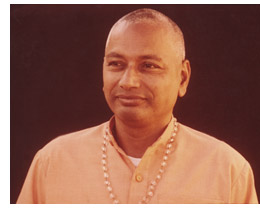 Swami returned to Perth towards the end of 1968, where he stayed at the home of devotees. During this time he visited several yoga classes and other venues such as a Jewish synagogue and Christian churches, including St George’s Cathedral, where his talks were greatly appreciated.
Swami returned to Perth towards the end of 1968, where he stayed at the home of devotees. During this time he visited several yoga classes and other venues such as a Jewish synagogue and Christian churches, including St George’s Cathedral, where his talks were greatly appreciated.
He then left for India, where he stayed in Madras with his purvashram family. Two memorable visits to Tirupathi Temple in Andhra Pradesh were taken during this Indian visit, where one Australian devotee had a life-changing experience in the temple.
In early 1969 he visited the Sivananda Ashram at Rishikesh where devotees from England and Australia were eager to hear his talks on various aspects of Yoga, and to bask in his divine presence. He also travelled to Calcutta, stopping off at Monghyr to visit his gurubhai, Swami Satyananda. One devotee was sent to Bombay and Poona to take classes with B.K.S. Iyengar, who subsequently visited South Africa and Mauritius and made other worldwide contacts.
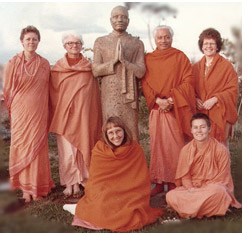 After 1969, Swami visited Perth almost every year. Each visit saw more and more people joining in satsang and filling the hall to capacity during the public talks. His talks were transcribed and turned into booklets.
After 1969, Swami visited Perth almost every year. Each visit saw more and more people joining in satsang and filling the hall to capacity during the public talks. His talks were transcribed and turned into booklets.
During these years he carried his typewriter with him, working on the Supreme Yoga (Yoga Vasistha).
He was a guest speaker at the International Yoga Teachers Seminar in 1972, held at a beautiful venue in the mountains near Sydney. Here the devotee gave a demonstration of the yoga of B.K.S Iyengar, sparking great interest and resulting in many of the teachers present visiting Poona—thus enabling the teaching to spread throughout all states of Australia, New Zealand and Fiji.
Swami then journeyed to New Zealand, where he traveled to several towns, staying with friends and conducting meditation classes, talks and discussions every day. A 10-day yoga retreat was conducted at a beautiful Centre in the middle of the North Island, where Swami became the pivot of each days activities—talks, discussions, stories, and chatting with the participants.
In a discussion at Lane Cove in Sydney, a student asked “How to be free from tension?” Swamiji said he did not have first-hand experience of tension. “I have seen it, “ he said, “but I have not directly experienced it.” He initiated the discussion:
“Why does one get into the state of tension at all in the first place? If you do not pick up tension, you do not have to drop it, you do not have to relax. It seems to me that once you are tense, an effort to relax makes you more tense! Therefore, all the different methods lead no where; and as a famous psychologist is reported to have said, “Drugs will continue to be the mainstay in the treatment of people suffering from tension.”
Hence, too, the yoga relaxation, etc fails to produce lasting results. In the yoga class people relax because the help and support comes from the teacher: but outside the class, tension returns.
One of the yoga students in Lane Cove (an aged lady) pointed to the real cause: which is “the competitive structure of our society.” Exactly! And so long as this competitive spirit lasts, tension is inevitable Swami said to them (half in jest):
“If two of us are engaged in the same work and you make it and I do not, I feel we are two. You did it–and that is 50% of me! You were the first and I the second. Together we made the team. Therefore I am happy too.
The competitive spirit is destroying society. The loser loses confidence in himself - which he might endeavour to compensate by becoming aggressive, violent, desperate or despondent. The winner also loses – loses his friends, peace of mind sleep, health and happiness – and he lives in perpetual fear of losing his gain!”
In April 1974, Swami spoke at a Rotary Club meeting at Rossmoyne:
“If you look at your own life, culture, upbringing, education, the books and the newspapers that you read, the propaganda that you listen to – you hardly find any serious mention of this commonness of humanity. Even in religious teaching this commonness of humanity is treated with a flippant superficiality, which makes no impression on anyone.
;Yet, religion is not religion if it does not enable us to see that as human beings, we are one.
If we are serious, we discover that somehow something deep within each one of us has resisted this religious spirit and rejected it. The spirit of religion has failed to touch and to transform it. On the other hand the divisive factor that lies deep within each one of us has even polluted the spirit of religion.
I remember the day I landed in South Africa in 1961. I was asked by a newspaper reporter what I consider is the best solution to the problems that beset the world. I answered ‘Religion.’ A gentleman who heard this wrote complimenting me on this and queried: ‘Which religion did you refer to?’ He was keen to reassure himself that it was his religion that I spoke about. So you and I do not talk about religion or God; we talk about ‘my religion’ and ‘my God’. But that is not religion! I have no first-hand knowledge about the particular problems connected with the Arab-Israeli conflict, the Catholic-Protestant conflict, or the Capitalistic-Communist conflict, but I was witness to the way in which the Hindu-Muslim riots were sparked off in what is known today as Bangladesh. I was there on the very day that the rioting broke out. For weeks before this the Hindus and the Muslims were living in friendship. Muslims used to come to the religions meetings we had organised in Hindu style. But the pollution of politics poisoned the atmosphere in a couple of days, and brothers were at each other’s throats.
This selfishness corrupts every aspect of our personality, relationships, society and even our religious practices. As long as the ‘me’ dominates our life, we are not religious, however loudly we may proclaim to the contrary.”
South Africa: Later Years
In Johannesburg, Jyotsna Mata made her home available to Swami and a few of his close disciples. The early morning meditations in his presence during the last days were very special indeed.
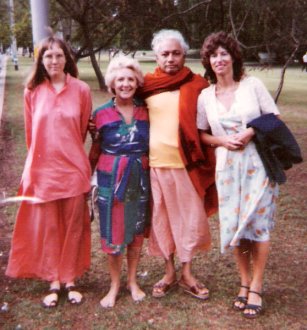
Swami Venkatesananda with Swami Sushila, Val Davidson and Ananda on the last walk at Zoo Lake in Johannesburg.
In the evenings there was often a talk and many people would cram the hall to hear him. In Cape Town on previous years Swami would stay with Sushila and Ramani in their house near to the centre of Cape Town. From here his program would be coordinated and satsangs and outings arranged. There was always a steady stream of devotees and disciples to the house where he was staying and each would have a task or duty allotted.
Ananda Kutir Yoga Centre run by Yogeshwari played host to many of his evening speeches. From modest beginnings in a small hall in the back garden of a suburban house, Ananda Kutir Cape Town later grew steadily and soon an ashram took shape. Today it is a vibrant hub of community service and an ashram in the truest sense of the word.
Swami Venkatesananda took Maha samadhi in Johannesburg, South Africa on December 2, 1982. Leading up to this time he had been playful and warned us repeatedly that he was about to go. None of us wanted to accept or believe it, we all wanted him to stay and be with us in his physical form. The last years in South Africa were profound. Days spent in his presence were like rare gems. Each opportunity to sit close to him and imbibe his wisdom was precious.

